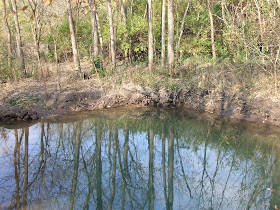When it comes to situations that create the possibility of precious metal ore to be present in our predominately sedimentary rocks of Kentucky, they are rare, for sure. Geologist consider the far reaching coal beds and limestone sediments formed from decaying swamp forests and marine bottom deposits respectively to offer little room for the right type of activity that would allow the presence of silver or other precious minerals. There are exceptions, as I've pointed out in the past. Take for example the curious
peridotite deposits in Elliot County, Kentucky or the channel fill as describe of
Bell Falls in the Red River Gorge.
 |
| The Glencarien fault |
In our discussions, we must not forget the many fault systems in our state. A fault is simply a place where the earth breaks and the land is moving apart in two different direction. There are different kinds of faults but basically, on one side of the fault the land is moving up or down relative to the rock and ground on the opposite side. Imagine breaking an arm bone and it becomes separated, moving apart. The obvious pain not withstanding, the bone is broken and moves apart in different directions. The doctor "sets" the bone by moving (painfully) back together. A fault is just like that, though it will never likely move back together.
 |
| The rock beds are tilted causing a shallow water fall |
Now a fault is ultra slow moving, taking centuries to move only a few inches. However, sometimes they move with extreme speed and large distances. We saw this in the Japanese earthquake earlier this year.
 |
| The very contact point of two opposite moving masses of stone |
If the fault reaches deep enough into the earth sometime in its life and gets close enough to the hot gases, and molten materials deep within our crust, some of these gases can carrying minerals to the surface. Over eons of time the cooling uprising of the gases through the fault cracks can produce deposits of minerals. And yes, silver ore can be one of these deposits. There could be and likely are many faults that are not even exposed at the surface of the earth today, they existed millions of years ago and have long since been covered by other rock deposits in the earths never, ever ending changing events.
 |
| Striation marks or scratches are called slicken sides |
The faults we see in Kentucky today on the surface at this point have not been known to produce anything other than the rock that is present on the fault. One such fault I really like is the Glencarien fault. It is located just southeast of Natural Bridge State Park which is part of the Red River Gorge area. Here the limestones and shales have broken apart, tilting slightly dropping one side down dramatically below the other. The fault like continues for miles but can only be observed here.










